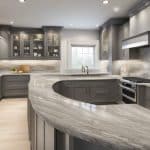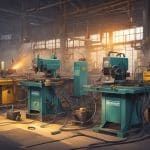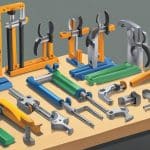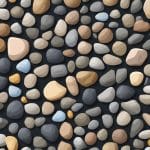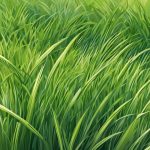Types Of Plywood
Plywood is a popular building material that has been used for centuries. It is made by gluing together thin layers of wood, known as veneers, to create a strong and durable sheet. Plywood is used for a wide range of applications, from construction and furniture making to packaging and shipping.
There are many different types of plywood available, each with its own unique properties and uses. Some of the most common types of plywood include sanded plywood, hardwood plywood, and marine plywood. Sanded plywood is ideal for painting or staining, while hardwood plywood is strong and durable, making it perfect for furniture making. Marine plywood is designed to withstand water and moisture, making it ideal for boat building and other outdoor projects.
Key Takeaways
- Plywood is a versatile building material that is used for a wide range of applications.
- There are many different types of plywood available, each with its own unique properties and uses.
- Choosing the right type of plywood for your project is important to ensure that it is strong, durable, and able to withstand the demands of its intended use.
Types and Applications

Plywood is a versatile material that is used in a wide range of applications. It is made by gluing together thin layers of wood veneer, and the quality of the plywood depends on the type of wood used, the thickness of the veneers, and the adhesive used. Here are some of the most common types of plywood and their applications.
Softwood Plywood
Softwood plywood is made from coniferous trees such as pine, spruce, and cedar. It is the most common type of plywood and is used in a wide range of applications, including construction, furniture, and outdoor projects. Softwood plywood is relatively inexpensive and easy to work with, but it is not as strong or durable as hardwood plywood.
Hardwood Plywood
Hardwood plywood is made from hardwood trees such as oak, birch, and maple. It is stronger and more durable than softwood plywood, and it is often used in high-end furniture, cabinetry, and architectural millwork. Hardwood plywood is more expensive than softwood plywood, but it offers superior strength and durability.
Marine Plywood
Marine plywood is a type of hardwood plywood that is specifically designed for use in boats and other marine applications. It is made with waterproof glue and is highly resistant to water and moisture. Marine plywood is also used in outdoor furniture and other projects that are exposed to water and moisture.
Aircraft Plywood
Aircraft plywood is a type of hardwood plywood that is used in the construction of aircraft and other high-stress applications. It is made with high-quality hardwood veneers and is designed to be strong, lightweight, and durable. Aircraft plywood is also used in other applications that require high strength and durability, such as bridges and other structural projects.
Structural Plywood
Structural plywood is a type of plywood that is designed for use in construction projects. It is made with high-quality veneers and is engineered to be strong and durable. Structural plywood is used in a wide range of applications, including flooring, roofing, and wall sheathing.
Overlaid Plywood
Overlaid plywood is a type of plywood that is covered with a thin layer of hardwood veneer. This veneer is used to improve the appearance of the plywood and to make it more durable. Overlaid plywood is often used in furniture and other decorative applications.
Flexible Plywood
Flexible plywood is a type of plywood that is designed to be flexible and bendable. It is made with thin veneers that are glued together in a cross-grain pattern, which gives the plywood its flexibility. Flexible plywood is often used in curved furniture and other projects that require a flexible material.
In summary, plywood is a versatile material that can be used in a wide range of applications. The type of plywood used depends on the specific application and the desired strength and durability. Softwood plywood is the most common type of plywood and is used in a wide range of applications, while hardwood plywood is stronger and more durable and is often used in high-end furniture and other decorative applications. Marine plywood is designed for use in boats and other marine applications, while aircraft plywood is used in high-stress applications such as aircraft and bridges. Structural plywood is designed for use in construction projects, while overlaid plywood is often used in furniture and other decorative applications. Flexible plywood is designed to be flexible and bendable and is often used in curved furniture and other projects.
Plywood Grades and Quality
Plywood is available in different grades and quality levels, which are determined by the type of wood used, the number of layers, and the quality of the veneers used. The grading system for plywood is based on the quality of the face and back veneers, with A being the highest quality and D being the lowest.
Grade A
Grade A plywood is the highest quality plywood available. It has a smooth, sanded surface with no knots or defects. It is ideal for use in high-end cabinetry, furniture, and other fine woodworking projects where a high-quality finish is desired.
Grade B
Grade B plywood is also of high quality, but it may have some minor defects such as knots, patches, or discoloration. It is suitable for use in furniture, cabinets, and other projects where appearance is important but not critical.
Grade C
Grade C plywood has more defects than Grade B, including knots, patches, and discoloration. It is often used in construction and other applications where appearance is not as important.
Lumber Core Plywood
Lumber core plywood is made with a solid wood core, usually of softwood, which is then covered with veneers. It is stronger and more stable than regular plywood, making it ideal for use in applications where strength is important, such as flooring and subflooring.
Veneer Grades
The quality of the veneers used in plywood is also graded, with A being the highest quality and D being the lowest. The grading is based on the number of defects, such as knots and splits, in the veneer. Higher quality veneers are used in higher grade plywood, while lower quality veneers are used in lower grade plywood.
In conclusion, understanding the different grades of plywood is important when choosing the right plywood for your project. Higher quality plywood will produce better results in high-end woodworking projects, while lower quality plywood is suitable for construction and other applications where appearance is not as important.
Manufacturing Process
Plywood is a composite material made from thin layers or plies of wood veneer that are glued together with an adhesive to form a strong and durable sheet. The manufacturing process of plywood involves several complex steps to ensure that the final product is of high quality and meets industry standards.
Veneer Sourcing
The first step in the manufacturing process of plywood is the selection of high-quality raw materials. The primary source of wood veneer is timber, which is typically obtained from sustainable forests. Trees are carefully chosen for their wood quality and environmental sustainability. Once harvested, the logs are transported to the plywood mill.
At the mill, the logs are debarked and cut into smaller pieces called bolts. The bolts are then steamed to soften the wood and make it easier to peel into thin sheets or veneers. The veneers are sorted by size and quality and then dried to remove any remaining moisture.
Ply Formation
The next step in the manufacturing process is the formation of the plywood sheets. The veneers are glued together with an adhesive to form a strong and durable sheet. The number of plies used in a sheet of plywood can vary depending on the desired thickness and strength of the final product.
The plies are arranged with the grain of each layer running perpendicular to the previous layer. This cross-grain construction gives plywood its strength and durability. The plies are then pressed together under high pressure to form a solid sheet.
Adhesive Bonding
The adhesive used in the manufacturing process of plywood is a critical component of the final product. The adhesive must be strong enough to hold the plies together but also flexible enough to allow for expansion and contraction of the wood.
There are several types of adhesives used in the manufacturing of plywood, including urea-formaldehyde, phenol-formaldehyde, and melamine-formaldehyde. Each type of adhesive has its own unique properties and is selected based on the desired strength and durability of the final product.
Pressing and Finishing
The final step in the manufacturing process of plywood is the pressing and finishing of the sheets. The glued plies are placed in a hot press and subjected to high pressure and temperature to ensure a strong and durable bond.
After pressing, the plywood sheets are trimmed to size and sanded to create a smooth and even surface. The sanding process also helps to remove any imperfections or blemishes in the wood.
In conclusion, the manufacturing process of plywood involves several complex steps that are designed to ensure a strong and durable final product. The quality of the raw materials, the adhesive used, and the pressing and finishing techniques all play a critical role in the strength and durability of the final product.
Physical Properties
When it comes to plywood, there are several physical properties that are important to consider. These properties include the thickness and size of the plywood, as well as its strength and stability. Additionally, the moisture and rot resistance of plywood is also an important factor to consider, especially when using the material in outdoor or wet environments.
Thickness and Size
Plywood is available in a variety of thicknesses, ranging from 1/8 inch to over 1 ¬Ω inches thick. The thickness of the plywood you choose will depend on the needs of your project. Plywood panels are generally available in three main sizes, which are 4 ft. x 8 ft., 4 ft. x 9 ft., and 4 ft. by 4 ft.
Strength and Stability
The strength and stability of plywood is determined by the number of plies it has. Plywood with more plies is generally stronger and more stable than plywood with fewer plies. Additionally, the type of wood used to make the plywood can also affect its strength and stability. Structural plywood is a type of plywood that is used for building permanent structures that require high strength. This type of plywood is perfect for beams, flooring, bracing panels, and formworks.
Moisture and Rot Resistance
The moisture and rot resistance of plywood is an important factor to consider, especially when using the material in outdoor or wet environments. Marine grade plywood is a type of plywood that is specifically designed for use in wet environments. It is made with water-resistant glue and is designed to resist rot, mildew, and weather damage. Additionally, some types of plywood are treated with chemicals to improve their moisture and rot resistance. However, it is important to note that no plywood is completely waterproof, and prolonged exposure to water can still cause damage to the material.
Plywood in Construction and DIY
Plywood is a versatile building material that can be used in a variety of construction and DIY projects. Here are some common uses for plywood in different areas of construction and DIY:
Flooring and Subflooring
Plywood is often used as a subflooring material in flooring installations. It provides a sturdy and stable base for flooring materials such as hardwood, tile, and carpet. Plywood is also commonly used as an underlayment for vinyl flooring.
Roofing and Sheathing
Plywood is a popular choice for roofing and sheathing applications due to its strength and durability. It is often used as a base layer for roofing materials such as shingles, tiles, and metal roofing. Plywood is also commonly used as a sheathing material for walls and roofs.
Walls and Cabinetry
Plywood is a popular choice for wall paneling and cabinetry due to its strength and durability. It can be used to create decorative wall panels, as well as functional cabinetry and shelving units. Plywood is also commonly used as a backing material for tile and other wall coverings.
Furniture Making
Plywood is a popular choice for furniture making due to its strength, durability, and versatility. It can be used to create a wide range of furniture pieces, from simple shelves and cabinets to complex chairs and tables. Plywood is also commonly used as a backing material for upholstered furniture.
Overall, plywood is a versatile and reliable building material that can be used in a wide range of construction and DIY projects. Whether you’re building a shed, installing new flooring, or creating custom cabinetry, plywood is a great choice for your next project.

